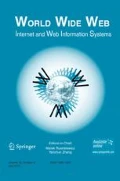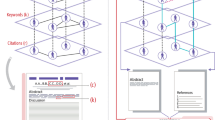Abstract
Link prediction plays an important role in scientific collaboration networks, and can favourably affect the organization of international scientific projects. In this paper, a meta-path computed prediction (MPCP) algorithm for link prediction among scientists and publications is presented. The MPCP algorithm is based on a heterogeneous information network model composed of authors and keywords in articles retrieved from the Web of Science database. Two kinds of meta-paths are defined: Author to Author to Author (A-A-A) and Author to Direction to Author (A-D-A). By calculating A-A-A and A-D-A using the heterogeneous information network model, the predictive strength of the links can be computed. The overlap of the meta-paths is also taken into account. By restoring links and calculating the number of restored links with different standard values, similar results are achieved for (quantum communication and link prediction). The number of restored links decreases as a special threshold value increases. The experimental studies show that, for any threshold value up to 1, at least 50% of links are restored. The results presented in this paper verify that the algorithm is a feasible means of predicting collaboration among scientists.


















Similar content being viewed by others
References
Coccia, M., Wang, L.: Evolution and convergence of the patterns of international scientific collaboration[J]. Proceedings of the National Academy of Sciences of the United States of America. 113(8), 2057(2016)
Newman, M.E.: Scientific collaboration networks. I. Network construction and fundamental results [J]. Physical Review E Statistical Nonlinear & Soft Matter Physics. 64(2), 016131(2001)
Newman, M.E.: The Structure of Scientific Collaboration Networks[J]. Proceedings of the National Academy of Sciences of the United States of America. 98(2), 404–409(2001)
Newman, M.E.: Coauthorship Networks and Patterns of Scientific Collaboration[J]. Proceedings of the National Academy of Sciences of the United States of America. 101(Suppl 1), 5200(2004)
Haddad, E.A., Mena-Chalco, J.P., Sidone, O.J.G.: Scholarly Collaboration in Regional Science in Developing Countries: The Case of the Brazilian REAL Network[J]. International Regional Science Review. 40(5), 500–529(2017)
Abbasi, A., Hossain, L., Leydesdorff, L.: Betweenness centrality as a driver of preferential attachment in the evolution of research collaboration networks[J]. Journal of Informetrics. 6(3), 403–412(2012)
Milojević, S.: Principles of scientific research team formation and evolution[J]. Proceedings of the National Academy of Sciences of the United States of America. 111(11), 3984–9(2014)
Kenekayoro, P., Buckley, K.: Thelwall, M.: Hyperlinks as inter-university collaboration indicators[J]. Journal of Information Science. 40(4), 514–522(2014)
Peng, W., Baowen, X.U., Yurong, W.U., et al.: Link prediction in social networks: the state-of-the-art[J]. Science China Information Sciences. 58(1), 11101–011101(2015)
He, Y.L., Liu, J.N.K., Hu, Y.X., et al.: OWA operator based link prediction ensemble for social network[J]. Expert Systems with Applications. 42(1), 21–50(2015)
Ghasemian, F., Zamanifar, K., Ghasem-Aqaee, N., et al.: Toward a better scientific collaboration success prediction model through the feature space expansion[J]. Scientometrics. 108(2), 777–801(2016)
Lu, L.Y., Pan, L., Zhou, T., et al.: Toward link predictability of complex networks[J]. Proceedings of the National Academy of Sciences of the United States of America. 112(8), 2325–30(2015)
Valverde-Rebaza, J.C., Roche, M., Poncelet, P., et al.: The role of location and social strength for friendship prediction in location-based social networks[J]. Information Processing & Management. 54(4), 475–489(2018)
Sett, N., Basu, S., Nandi, S., et al.: Temporal link prediction in multi-relational network[J]. World Wide Web-internet. Web Inf. Syst, 21(2), 395–419(2018)
Symeonidis, P., Tiakas, E.: Transitive node similarity: predicting and recommending links in signed social networks[J]. World Wide Web-internet. Web Inf. Syst. 17(4), 743–776(2014)
Gleich, D.F.: PageRank beyond the Web[J]. Computer Science. 57, 3(2014)
Li, Y., Luo, P., Fan, Z.P., et al.: A utility-based link prediction method in social networks[J]. European Journal of Operational Research. 260(2), 693–705(2016)
Kefalas, P., Symeonidis, P., Manolopoulos, Y.: Recommendations based on a heterogeneous spatio-temporal social network[J]. World Wide Web-internet. Web Inf. Syst. 21(2), 345–371(2017)
Li, F, He, Jing, Huang, G, Zhang, Yanchun , Shi, Y and Zhou, Rui Node-coupling clustering approaches for link prediction. Knowledge-Based Systems, 89. 669–680 (2015)
Muhan Zhang, Yixin Chen. Link Prediction Based on Graph Neural Networks. Advances in Neural Information Processing Systems 31, Monreal, Canada, (NIPS 2018)
Haeran Cho, Yi Yu. Link Prediction for Interdisciplinary Collaboration Via Co-Authorship Network, Social Network Analysis and Mining, 8 (1), 25 (2018)
Web of Science [DB/OL]. http://www.webofknowledge.com/wos. 21 March 2018
VOSviewer [EB/OL]. http://www.vosviewer.com/30 March 2018
Drożdż, S., Kulig, A., Kwapień, J., et al.: Hierarchical organization of H. Eugene Stanley scientific collaboration community in weighted network representation[J]. Journal of Informetrics 11(4), 1114–1127(2017)
Shi, C., Li, Y., Zhang, J., et al.: A Survey of Heterogeneous Information Network Analysis[J]. IEEE Transactions on Knowledge & Data Engineering. 29(1), 17–37(2015)
Gupta, M., Kumar, P., Bhasker, B.: HeteClass: a meta-path based framework for Transductive classification of objects in heterogeneous information networks[J]. Expert Syst. Appl. 68, 106–122 (2017)
Chiang, M.F., Liou, J.J., Wang, J.L., et al.: Exploring heterogeneous information networks and random walk with restart for academic search[J]. Knowledge & Information Systems. 36(1), 59–82(2013)
Yang, N., He, L., Li, Z., et al.: Reducing uncertainty of dynamic heterogeneous information networks: a fusing reconstructing approach[J]. Data Mining & Knowledge Discovery. 31(3), 879–906(2017)
Ma, Y., Yang, N., Zhang, L., et al.: Predicting neighbor label distributions in dynamic heterogeneous information networks[J]. World Wide Web-internet. Web Inf. Syst. 20(6), 1269–1291(2017)
Ozcan, A., Oguducu, S.G.: Link prediction in evolving heterogeneous networks using the NARX neural networks[J]. Knowledge & Information Systems. 55(2), 333–360(2018)
Li, J.C., Zhao, D.L., Ge, B.F., et al.: A link prediction method for heterogeneous networks based on BP neural network[J]. Physica A Statistical Mechanics & Its Applications. 495, 1–17 (2018)
Sun, Y., Han, J.: Meta-Path-Based Search and Mining in Heterogeneous Information Networks[J]. Tsinghua Science and Technology. 18(4), 329–338(2013)
Fu, G., Ding, Y., Seal, A., et al.: Predicting drug target interactions using meta-path-based semantic network analysis[J]. Bmc Bioinformatics. 17(1), 160(2016)
Qian, F., Gao, Y., Zhao, S., et al.: Combining topological properties and strong ties for link prediction[J]. Tsinghua Science and Technology. 22(6), 595–608(2017)
Huang, R., Yang, H., Bei, S., et al.: Bioinformatic Analysis Identifies Three Potentially Key Differentially Expressed Genes in Peripheral Blood Mononuclear Cells of Patients with Takayasu’s Arteritis[J]. Cell Journal. 19(4), 647–653(2018)
Liu, Y., Zeng, X., He, Z., et al.: Inferring microRNA-disease associations by random walk on a heterogeneous network with multiple data sources[J]. IEEE/ACM Transactions on Computational Biology & Bioinformatics. pp.1–1 (2016)
Gephi[EB/OL]. https://gephi.org/30 March 2018
Newman. M.E.: The Structure and Function of Complex Networks [J]. Siam Review. 45(2), 167–256(2003)
Acknowledgments
This work was financially supported by the Special Funding of “The Belt and Road” International Cooperation of Zhejiang Province (2015C04005).
Author information
Authors and Affiliations
Corresponding author
Additional information
Publisher’s note
Springer Nature remains neutral with regard to jurisdictional claims in published maps and institutional affiliations.
Highlights
• An algorithm for link prediction among scientists and publications is proposed.
• Importance of using heterogeneous information networks is discussed.
• Advantages of the proposed algorithm are confirmed via examples.
• Perspectives of using the proposed algorithm are discussed.
Rights and permissions
About this article
Cite this article
Lande, D., Fu, M., Guo, W. et al. Link prediction of scientific collaboration networks based on information retrieval. World Wide Web 23, 2239–2257 (2020). https://doi.org/10.1007/s11280-019-00768-9
Received:
Revised:
Accepted:
Published:
Issue Date:
DOI: https://doi.org/10.1007/s11280-019-00768-9




